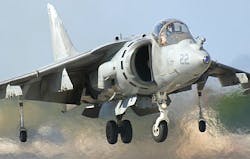Navy to install FACE-based avionics computer upgrade in Marine Corps AV-8B attack jet fleet
PATUXENT RIVER NAS, Md., 11 March 2013. U.S. Navy officials are carrying out a plan to upgrade the mission systems computer (MSC) for the U.S. Marine Corps Boeing AV-8B Harrier II attack jet with industry-standard interfaces that meet guidelines of the Future Airborne Capability Environment (FACE).
Officials of the Naval Air Systems Command at Patuxent River Naval Air Station, Md., announced their intention last week to award a sole-source contract to MSC designer General Dynamics Advanced Information Systems in Minneapolis to provide the MSC with a FACE interface structure running on top of the system's existing Wind River Systems VxWorks 5.5-based core systems software.
Navy avionics experts are ordering the FACE software upgrades to the Harrier's mission computer to enable the AV-8B's avionics to implement the required area navigation (RNP) and required navigation performance (RNAV) application.
The delivery order will call for General Dynamics to deliver a second Open System Processor 3 (OSP3) into the AV-8B mission computer, and provide it with FACE-based software for the RNP/RNAV application. The value of the order has yet to be negotiated.
The AV-8B Harrier II is a second-generation vertical- and short-takeoff and landing (V/STOL) ground-attack aircraft used primarily for light attack or multi-role missions. It can operate from aircraft carriers, amphibious assault ships, and simple forward-operating bases.
In addition to the Marine Corps, the AV-8B files with the Italian and Spanish navies. The Marines operate the AV-8B with seven attack squadrons, which use the jump jet for close air support, air interdiction, surveillance, and helicopter escort.
Eventually the Marines will replace their AV-8B aircraft with vertical- and short-takeoff and landing versions of the Lockheed Martin F-35 joint strike fighter.
The AV-8B's advanced mission computer is a VME-based processing system based on the Freescale Power-PC open-systems processor architecture. The mission computer can control mission computers and displays, digital maps, network processors, and servers.
The FACE technical standard, administered by the FACE industry consortium, providing guidelines for creating a common operating environment to support applications across U.S. military avionics systems. The standard helps enable developers to create and deploy applications across many military aviation systems through a common operating environment.
The standard introduces interoperability into an environment that traditionally has relied on the use of tightly coupled individual systems each with unique interfaces. General Dynamics is part of the FACE Consortium.
The Navy is awarding General Dynamics a sole-source contract because the company is the developer and manufacturer of the AV-8B's advanced mission computer and mission systems computer, and is the only company with the knowledge necessary to fill the contract in a timely manner, Navy officials say.
For more information contact General Dynamics Advanced Information Systems online at www.gd-ais.com, Naval Air Systems Command at www.navair.navy.mil, or the FACE Consortium at www.opengroup.org/getinvolved/consortia/face.


